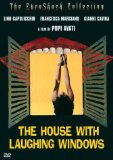Pupi Avati’s The House with Laughing Windows (1976) isn’t the most high-profile Italian horror film, and only landed a legit North American release with Image’s 2002 DVD release. But it has been a succès d’estime for quite some time, particularly in its homeland, and it is well worth tracking down. Viewers looking for something fast-paced, or a Lucio Fulci-style gorefest will be disappointed, but those willing to work with it will find a deeply atmospheric, disturbing and intelligent contemporary gothic with elements of the giallo.
Stefano (Lino Capolicchio) is an art restorer who arrives in an out-of-the-way village to rescue a damaged church fresco depicting the martyrdom of St. Sebastian. He is initially very impressed by the artist’s ability to capture pain, but the more he uncovers of the painting, and the more works by the deceased artist he sees, the more disturbed he is by the man’s obsessive depictions of cruelty and death. When a friend of his, who claims something terrible is happening in the village, is killed, Stefano is drawn further and further into a deadly mystery, at whose centre lies the impulse behind these gruesome images.
Avati was working on a tiny budget here (in the accompanying documentary, he claims the film was the cheapest one made in Italy that year), and so, barring a few very striking and nasty murders, there are no special effects. This is not, of course, a supernatural story, and yet there is a very uncanny atmosphere conjured by such simple means as a blowing curtain or (as has been pointed out elsewhere) a bag in an attic swinging for no discernible reason. Over and above these individual effects, however, there is the omnipresent fusion of art and decay presented by the setting. Everywhere the camera looks, it seems, there is a painting fading on masonry that has become distinctly leprous. This is a town that, despite its initially picturesque appearance, is rotten to the core. The inhabitants are caught and corrupted by a sordid past, a past that is visible in the form of eroded stone, crumbling houses and overgrown greenery.
Avati makes stunning use of a technique that goes back to Nosferatu (1922): shooting actual locations in such a way as to make them strange and unsettling. At various times, in various films, Mario Bava, Jean Rollin, Jess Franco and Amando De Ossorio (among others) would deploy this same tactic. It requires being able to look at European settings with the eyes of an outsider, to see the enormous age present in even the most ordinary locale, and how easily the architecture of an earlier century can appear threatening in the twentieth (or twenty-first, for that matter). I’m not necessarily talking here about gothic cathedrals and forbidden castles. An ordinary village street can be just as menacing, if we suddenly become conscious of how the width of the road doesn’t feel quite enough for the height of the houses, and of how those houses have windows that are both too small and perpetually shuttered.
Avati doesn’t stop here, though. Take the house of the title. It plays quite a small role in the film, but it is memorable. A large, abandoned building, it looks askew and hostile from the moment it first appears on the screen. Stefano walks around three sides of it, peers into the windows, see the utter decrepitude inside. The audience has no desire to see him enter the place. So bad enough already. But later, Stefano returns, and walks around to the fourth side. There, huge smiles are painted over the windows and shutters. No, the windows aren’t literally laughing, in the supernatural sense. But this simple image is powerfully disturbing, and is, as we see by the end of the film, a perfect encapsulation of the smiling sickness that lies at the heart of the village.
In sum, a film that shows how a talented filmmaker can give one a visceral understanding of the word “wrong” even while using very limited, very simple means.


